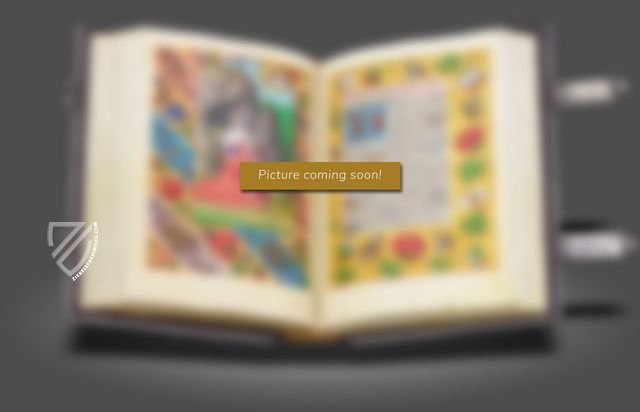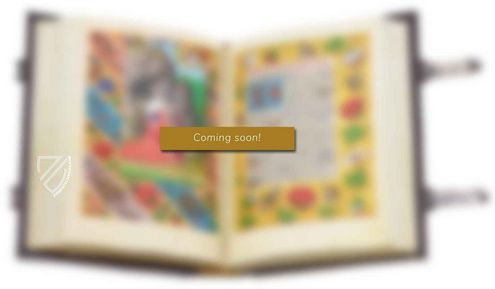Chantilly Codex
(under 1,000€)
The Chantilly Codex is a musical manuscript containing compositions from ca. 1350–1400 in the style known as the Ars subtilior, which is characterized by rhythmic and notational complexity and was prevalent in Paris, Avignon, and northern Spain in the late 14th century. It contains 112 polyphonic songs, mostly in French, including many of the most popular courtly dance styles of its time, such as ballades, roundels, virelais, and isorhythmic motets. Some of these motets are so rhythmically complex that they are written in intricately exact musical notation instead of simple neumes. The Chantilly Codex contains music from composers such as Johannes Symonis, Jehan Suzay, P. des Molins, Goscalch, Solage, Baude Cordier, Grimace, Guillaume de Machaut, Jehan Vaillant, F. Andrieu, Magister Franciscus, Johannes Cuvelier, Rodericus, Trebor, and Jacob Senleches.
Chantilly Codex
The so-called Chantilly Codex is one of the three main sources of ars subtilior, which is famous for its extremely complicated notation and the fine decoration that is found on some of the pages. Unlike most musical manuscripts from the period, most of the works are attributed to composers with only 34 anonymous pieces found in the manuscript. The 112 polyphonic songs in the manuscript consists of 70 ballads, 17 roundels, 12 virelais, and 13 isorhythmic motets. The 34 authors cited are: Baude Cordier, Johannes Haucourt, Matheus de Sancto Johanne, Petrus Fabri, Jacob Senleches, Jehan Vaillant, Solage, Guillaume de Machaut, Grimace, Magister Franciscus, Trebor, Magister Egidius Augustinus, Guido, Johannes Susay, Johannes Olivier, Philippus de Caserte, Johannes Galiot, Jehan Simon Hasprois, Garinus, Johannes Cunelier, Goscalch, Taillandier, Hymbert de Salinis, Johannes Cesaris, Rodericus, Johannes de Meruco, F. Andrieu, Pierre des Molins, Borlet, Pykini, Gacian Reyneau, Egidius de Pusiex, Philippe Royllart, J. Alanus.
An Italian Copy of a French Original
The large number of errors in the French text as well as in copying the scores indicates that this manuscript was copied from a French original by an Italian copyist who did not understand what he was copying. The texts were written down before the music, which creates a lag between the two. The decoration of the manuscript is left incomplete and blank spaces can be found where most of the initials should have been completed by an illuminator. Why the work was never completed remains unknown.
A Precious Discovery
An inscription on the title page from 1461 states the book was owned by the family of Francesco d'Altobianco Alberti, who had been banished from Florence in 1401 and lived for a long time in France. Exactly 400 years later, it was discovered in 1861 at the home of M. Bigazzi, secretary of the Accademia della Crusca, in Florence by Henry de Triqueti (1803–74) a French sculptor and enlightened amateur. Triqueti purchased the manuscript and adorned it with a frontispiece before donating it to the Bibliothèque du Château, Chantilly, after which it is named.
Codicology
- Alternative Titles
- Codex Chantilly
- Size / Format
- 211 pages / 40.0 × 29.0 cm
- Origin
- Italy
- Date
- End of the 14th or beginning of the 15th century
- Epochs
- Style
- Genre
- Content
- 112 music pieces
- Artist / School
- Solage, Philippus de Caserta, Trebor, Vaillant, Machaut, Senleches, Susay, Cordier, Magister Franciscus, Hasprois and others (composers)
- Previous Owners
- Henri d'Orléans, Duke of Aumale (1822–1897)
#1 Codex Chantilly
Languages: French, English
(under 1,000€)
- Treatises / Secular Books
- Apocalypses / Beatus
- Astronomy / Astrology
- Bestiaries
- Bibles / Gospels
- Chronicles / History / Law
- Geography / Maps
- Saints' Lives
- Islam / Oriental
- Judaism / Hebrew
- Single Leaf Collections
- Leonardo da Vinci
- Literature / Poetry
- Liturgical Manuscripts
- Medicine / Botany / Alchemy
- Music
- Mythology / Prophecies
- Psalters
- Other Religious Books
- Games / Hunting
- Private Devotion Books
- Other Genres
- Afghanistan
- Armenia
- Austria
- Belgium
- Colombia
- Croatia
- Czech Republic
- Denmark
- Egypt
- Ethiopia
- France
- Germany
- Hungary
- India
- Iran
- Iraq
- Israel
- Italy
- Japan
- Luxembourg
- Mexico
- Morocco
- Netherlands
- Peru
- Poland
- Portugal
- Russia
- Serbia
- Spain
- Sri Lanka
- Sweden
- Switzerland
- Syria
- Turkey
- Ukraine
- United Kingdom
- United States
- Uzbekistan
- Aboca Museum
- Ajuntament de Valencia
- Akademie Verlag
- Akademische Druck- u. Verlagsanstalt (ADEVA)
- Aldo Ausilio Editore - Bottega d’Erasmo
- Alecto Historical Editions
- Alkuin Verlag
- Almqvist & Wiksell
- Amilcare Pizzi
- Andreas & Andreas Verlagsbuchhandlung
- Archa 90
- Archiv Verlag
- Archivi Edizioni
- Arnold Verlag
- ARS
- Ars Magna
- ArtCodex
- AyN Ediciones
- Azimuth Editions
- Badenia Verlag
- Bärenreiter-Verlag
- Belser Verlag
- Belser Verlag / WK Wertkontor
- Benziger Verlag
- Bernardinum Wydawnictwo
- BiblioGemma
- Biblioteca Apostolica Vaticana (Vaticanstadt, Vaticanstadt)
- Bibliotheca Palatina Faksimile Verlag
- Bibliotheca Rara
- Boydell & Brewer
- Bramante Edizioni
- Brepols Publishers
- British Library
- C. Weckesser
- Caixa Catalunya
- Canesi
- CAPSA, Ars Scriptoria
- Caratzas Brothers, Publishers
- Carus Verlag
- Circulo Cientifico
- Club Bibliófilo Versol
- Club du Livre
- CM Editores
- Collegium Graphicum
- Collezione Apocrifa Da Vinci
- Comissão Nacional para as Comemorações dos Descobrimentos Portugueses
- Coron Verlag
- Corvina
- CTHS
- D. S. Brewer
- De Agostini/UTET
- De Schutter
- Deuschle & Stemmle
- Deutscher Verlag für Kunstwissenschaft
- DIAMM
- Droz
- E. Schreiber Graphische Kunstanstalten
- Ediciones Boreal
- Ediciones Grial
- Ediclube
- Edições Inapa
- Edilan
- Editalia
- Edition Georg Popp
- Edition Leipzig
- Edition Libri Illustri
- Editiones Reales Sitios S. L.
- Éditions de l'Oiseau Lyre
- Editions Medicina Rara
- Editorial Casariego
- Editorial Mintzoa
- Editrice Antenore
- Editrice Velar
- Edizioni Edison
- Egeria, S.L.
- Eikon Editores
- Electa
- Enciclopèdia Catalana
- Eos-Verlag
- Ephesus Publishing
- Eugrammia Press
- Extraordinary Editions
- Fackelverlag
- Facsimila Art & Edition
- Facsimile Editions Ltd.
- Facsimilia Art & Edition Ebert KG
- Faksimile Verlag
- Feuermann Verlag
- Folger Shakespeare Library
- Franco Cosimo Panini Editore
- Friedrich Wittig Verlag
- Fundación Hullera Vasco-Leonesa
- G. Braziller
- Gabriele Mazzotta Editore
- Gebr. Mann Verlag
- Gesellschaft für graphische Industrie
- Getty Research Institute
- Giovanni Domenico de Rossi
- Giunti Editore
- Graffiti
- Grafica European Center of Fine Arts
- Guido Pressler
- Guillermo Blazquez
- H. N. Abrams
- Harrassowitz
- Helikon
- Hendrickson Publishers
- Henning Oppermann
- Herder Verlag
- Hes & De Graaf Publishers
- Hoepli
- Hortus Deliciarum
- Houghton Library
- Hugo Schmidt Verlag
- Idion Verlag
- Il Bulino, edizioni d'arte
- ILte
- Imago
- Insel Verlag
- Instituto de Estudios Altoaragoneses
- Instituto Nacional de Antropología e Historia
- Istituto dell'Enciclopedia Italiana - Treccani
- Istituto Ellenico di Studi Bizantini e Postbizantini
- Istituto Geografico De Agostini
- Istituto Poligrafico e Zecca dello Stato
- Italarte Art Establishments
- J. Thorbecke
- Jan Thorbecke Verlag
- Johnson Reprint Corporation
- Jugoslavija
- Karl W. Hiersemann
- Kasper Straube
- Kaydeda Ediciones
- Konrad Kölbl Verlag
- Kurt Wolff Verlag
- La Liberia dello Stato
- La Linea Editrice
- La Meta Editore
- Lambert Schneider
- Landeskreditbank Baden-Württemberg
- Leo S. Olschki
- Les Incunables
- Library of Congress
- Libreria Musicale Italiana
- Lichtdruck
- Lito Immagine Editore
- Lumen Artis
- Lund Humphries
- M. Moleiro Editor
- Maison des Sciences de l'homme et de la société de Poitiers
- Manuscriptum
- Maruzen-Yushodo Co. Ltd.
- MASA
- McGraw-Hill
- Militos
- Millennium Liber
- Müller & Schindler
- National Library of Wales
- Neri Pozza
- Nova Charta
- Oceanum Verlag
- Odeon
- Orbis Mediaevalis
- Orbis Pictus
- Österreichische Staatsdruckerei
- Oxford University Press
- Pageant Books
- Parzellers Buchverlag
- Patrimonio Ediciones
- Pattloch Verlag
- PIAF
- Pieper Verlag
- Plon-Nourrit et cie
- Prestel Verlag
- Princeton University Press
- Prisma Verlag
- Priuli & Verlucca, editori
- Pro Sport Verlag
- Propyläen Verlag
- Pytheas Books
- Quaternio Verlag Luzern
- Reales Sitios
- Recht-Verlag
- Reichert Verlag
- Reichsdruckerei
- Riehn & Reusch
- Roberto Vattori Editore
- Rosenkilde and Bagger
- Roxburghe Club
- Salerno Editrice
- Sarajevo Svjetlost
- Schöck ArtPrint Kft.
- Scolar Press
- Scrinium
- Scripta Maneant
- Scriptorium
- Siloé, arte y bibliofilia
- SISMEL - Edizioni del Galluzzo
- Sociedad Mexicana de Antropología
- Sorli Ediciones
- Stainer and Bell
- Styria Verlag
- Sumptibus Pragopress
- Szegedi Tudomànyegyetem
- Taberna Libraria
- Tarshish Books
- Taschen
- Tempus Libri
- Testimonio Compañía Editorial
- Thames and Hudson
- The Clear Vue Publishing Partnership Limited
- The Facsimile Codex
- The Folio Society
- The Marquess of Normanby
- The Richard III and Yorkist History Trust
- Tip.Le.Co
- TouchArt
- TREC Publishing House
- TRI Publishing Co.
- Trident Editore
- Typis Regiae Officinae Polygraphicae
- Universidad de Granada
- University of California Press
- University of Chicago Press
- Urs Graf
- Vallecchi
- Van Wijnen
- VCH, Acta Humaniora
- VDI Verlag
- Verlag für Regionalgeschichte
- Verlag Styria
- Vicent Garcia Editores
- W. Turnowsky
- Wiener Mechitharisten-Congregation (Wien, Österreich)
- Wissenschaftliche Buchgesellschaft
- Xuntanza Editorial
- Zollikofer AG




